[NOTE: For some reason, the comments on this post were not available when it was first published earlier today (9/30). I’ve re-published it and moved it up on the page to give folks another chance to comment. — Editor]
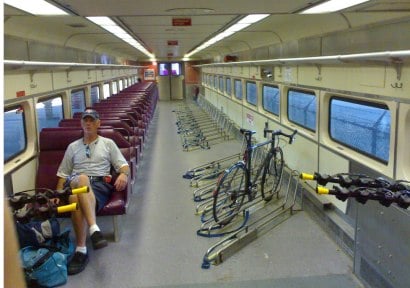
(Photo by captaindisko/Flickr)
Over the weekend, I came across a striking photo (via the Shift email list) of a commuter train in Boston where an entire half of the train had been given over to bike parking.
According to an article in the Boston Globe published in June of 2006, there are 39 bike racks on this commuter rail line. The Massachusetts Bay Transit Authority (MBTA) added a similar configuration on another line in May of this year.
The MBTA says bikes are allowed on these specially equipped trains only on weekends and some holidays.
Here in Portland (and all over the country), our regional transit operator, TriMet, is also struggling to find room for bikes. TriMet has made it clear that they are not going to add bike capacity on MAX trains (newly purchased cars have no increased bike capacity).

(Photo © J. Maus)
At the recent Pro Walk/Pro Bike conference in Seattle, TriMet’s director of communications, Carolyn Young, gave a presentation titled, Bikes and Transit. She said TriMet “values having bikes on board” (one of her slides featured the Zoobombers’ Sunday exploits) but added that “it creates a conflict” and “there’s not enough space”.
On the topic of bike parking at MAX stations, Young admitted that TriMet is “woefully inadequate”. Young also said that adding more hooks and more bike capacity on trains is “just not the answer”.
On that note, here’s a slide from Young’s presentation:
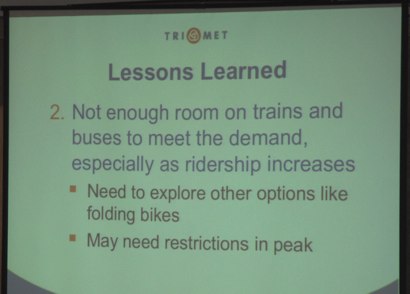
I was interested to see “may need restrictions in peak” because TriMet has denied any rush-hour bike ban in the past.
Just how big of an issue is bike capacity on MAX trains?
A recent survey conducted by TriMet found that 3.8% of their riders bring bikes on board and that there are an estimated 2,100 bike trips each weekday (including one in 10 riders on the northbound Yellow Line up Interstate Ave.).
Another finding from the survey was that 39% of those who currently take bikes on board said they would drive a car instead if there was no space for their bike. However, during her presentation in Seattle, Young dismissed that particular factoid because a “blog skewed the response…they knew that’s what we didn’t want to hear.”
Ms. Young might be referring to BikePortland.org, but the only thing this blog is guilty of is helping TriMet publicize their online survey (half of the total respondents came from this site).
So, what’s next for bikes and TriMet? Here’s another slide…
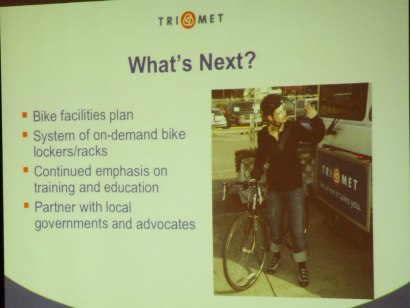
So, while some continue to be frustrated about TriMet’s unwillingness to explore solutions that would add bike capacity to trains, it’s clearly not in their plans at this point. I have also not heard any plans for a large-scale bike parking facility (something similar to the massive motor vehicle park-and-rides they operate).
Instead of individual, “on-demand” lockers (like this one in Vancouver, Washington), I like the direction the MBTA is going.
Earlier this month, they unveiled two new bike parking cages at a transit station. The cages have room for 300 bikes and are accessed via a special card.
(The irony here is that Boston is perennially named as the most bike un-friendly city in the nation.)
While I would love to see TriMet try something creative and bold to increase on-board bike capacity, I also realize that it’s TriMet’s job is to move people, not bikes. If that’s the case, they need to create ample and secure bike parking facilities that encourage more riders to park and ride.
If they don’t address the issue, they’ll only help perpetuate the feelings expressed by this person on the Shift email list (posted after seeing the Boston bike train photo):
“This is such a totally awesome implementation that I donít see any reason why Tri-Met canít do it. We need to stop making excuses Ė if Tri-Met canít handle the load, they need more trains. If they canít do it on their own, then maybe it needs to be a fully public agency rather than a public-private partnership or whatever the heck they are.”

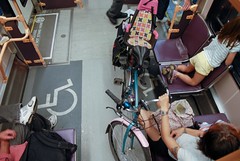


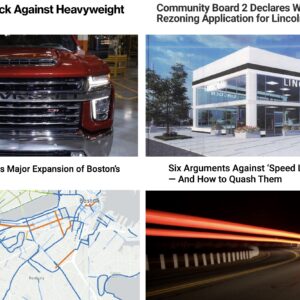

Now we’re talking…..! That rack arrangement in the top picture looks just great…it might require a little more engineering, but probably a little more aisle space could be created if the racks allowed bikes to be mounted vertically.
Couple things:
0) While that is a great design of the MBTA train, why is there only one bicycle on it? If I was a non-bicyclist that lived in Boston, I might have some complaints about how the public transit agency was spending their money…
However: TriMet:
1) The low floor cars can hold 166 people, but there are only 64 seats. So really, once you pass 100 people or so, the train has gotten pretty full, (regardless of if you have a bicycle or not.) 3.8% of riders currently bring their bicycle on board, so that is 4 bicycles per 105 passengers. Yes, if they added 2 more hooks, that would be 157 people and 6 bicycles, (although a couple of Sherman tanks (baby carriages,) on board tend to knock out a lot of the room,) but not everyone uses a hook in the first place, so you’d just end up with empty hooks on a regular basis. So really the solution there is more trains*, and not more hooks.
2) The Yellow line (with 10% bicycle mode share) is a problem, but I think the big problem there is caused by single car trains at rush hour, (or even at 8pm,) and they should run two car trains all the time on that line and many of the crowding problem would go away, (all it takes to do that is more cars*, it doesn’t even take more drivers or anything on that line.)
3) Today I got on a blue line train at 5:06pm downtown, and their was room, and a hook available. I didn’t get on the one at 5:03 (because there wasn’t room,) and I’d just missed the one at 4:58 although it looked like there was room on it… The reason I bring this up is that a special bicycle only car wouldn’t run on every train, so you’d still end up waiting on the platform for the next train sometimes, and if you are willing to do that in the first place, you often times can get on now, (and a 3 minute wait isn’t bad at all, but that is what you get when they run a lot of trains* like they do at rush hour.)
4) TriMet is a public agency already. They are accountable to the governor, so a lot of people don’t feel like they have a fair say in what they do, and maybe that should be fixed, (run by Metro maybe?) but they are already public.
* What most of those point to is:
More train cars. Not necessarily different cars with different layouts, TriMet just needs more cars, and more drivers to drive them.
One further note to add: generally speaking, commuter trains run with lots of a cars and fewer frequencies, the commuter trains that run out of Chicago (where I’m from) usually run 6 or 8 cars the size of the one that’s pictured above. Dedicating one car out of 8 to bikes is a lot easier than dedicating one of two.
On the other hand, Trimet *should* be able to find a way to remove 6 seats from each car, especially considering they’re adding two in the next version of their car. 6 seats might be enough to add 4 additional bikes, which I think would go a long way towards satisfying demand on the train. That’s a big gain at a pretty small cost.
Another thing to note is that the MBTA train shown is an inter-city commuter rail train, with stops that are much further apart than the stops on the regular intra-city subway (they call it the “T”). It is more like Amtrak (and actually I think Amtrak even operates it). Usually everyone gets on at one stop in town and then at each stop people are mostly deboarding, unlike MAX, where people, yes, mostly board downtown, but at many different stops, with much more on-and-off traffic. The patterns of traffic on and off are different than MAX, so comparing this photo to MAX is a bit of apples to oranges.
“The patterns of traffic on and off are different than MAX, so comparing this photo to MAX is a bit of apples to oranges.”
Paul Cone,
I realize that.
I’m well aware of the limitations TriMet says they have and I realize the Boston example does not share those limitations.
I’m merely sharing what I found to be an interesting and aggressive bike/train configuration and I’m using it as a jumping-off point for the discussion.
Here is a link to the bike rules on the Boston T… the rules for the subway seem quite similar to MAX…
http://www.mbta.com/riding_the_t/bikes/
And actually, they seem more restrictive, if anything — “A maximum of two (2) bikes are allowed on each car on Blue, Red and Orange Line trains only.” And no bikes at all on the Green Line (which does make sense, though, given that line’s smaller cars.
Now, I wonder what TriMet’s bike plans for the WES are? I see no mention of bikes, except for parking at stations.
The problem with the trimet trains using such a car as in the photo, trimet trains can only go the length of one city block. And in peak hours we all know how packed those cars are. Trimet can’t load up to 3 or 4, not to mention 8 cars.
The seat configurations on the new MAX vehicles are so tight, they’re practically useless. Could’ve been more space for bikes and standees, which are more appropriate configurations for the shorter rides typical of people using MAX.
Bike parking enhancements have been a long time coming. It still amazes me that the agency will spend $100’s of millions on park-and-rides, but nearly nothing on bike parking.
“It still amazes me that the agency will spend $100’s of millions on park-and-rides, but nearly nothing on bike parking.”
Joe,
From what I’ve heard, this is due primarily to how the funding works. The Feds give TriMet money to build motor-vehicle park and rides and there is no equivalent pot of money for bike facilities.
Also, TriMet only builds bike facilities to code requirements of whatever city they’re building in… so on the West Side for instance, the city bike parking code requirements are pretty bad, therefore the bike parking is pretty bad.
If TriMet does something for bikes above and beyond what is required by code, they cannot get funding for it as easily (or at all).
this is a big, policy-related problem that i wish could be fixed. Or, TriMet could just say, “Screw your codes and funding, we know bike parking is essential, so we’re going to build an awesome facility.”.. but I haven’t seen that kind of commitment from TriMet yet.
“The MBTA says bikes are allowed on these specially equipped trains only on weekends and some holidays.”
Who cares if you can have a car full of bikes….If you can only use it on the weekends and some holidays!!!!! If your going to spend the money on the cars use them. What a tease.
Yawn…I fail to see how TriMet is “struggling to find room for bikes” when they’re not pursuing any options to actually expand capacity.
I think TriMet totally doesn’t get it. Bikes make for excellent first and last mile transport. When riders also ride their bike, often they can eliminate a bus connection (or two) and shorten their trip substantially. If they can get a 2 or 3 bus/walk/wait commute (read: 90-120 min) down to 1 bus + bike (read: 25 minutes) then people are more likely to consider TriMet as an option, rather than SOV driving.
I wish TriMet would see the potential in a bike/bus *partnership* that would increase ridership. Instead TriMet seems to see bikes as “something we have to deal with.” Ex: Solving “the problem” by providing additional storage to get people OFF of their bikes, the trip planner is pedestrian-only (i.e. it always calculates times/connections/etc in terms of walking to stops). WES has even fewer hooks than MAX. There is no exploration of 3-bike racks. We don’t allow bikes to take the disabled spots on buses when disabled folks don’t need them. etc etc etc.
The survey shows this – it says “if we can’t bring our bike, we’ll drive.” It doesn’t say “gee I wish I had a place to lock up my bike”; which is how TriMet seems to be responding.
I commuted on the Cal-Trains that go from San Jose to SF from 1993-1996. At first there was only room for 8 bikes. That soon maxed out. Then a whole back car had seats removed 24 bikes, that maxed out and cyclists got in fights with each other. At no point were there any passengers standing.
My point: Trimet is a dinosaur when it comes to bike issues. If they added capacity, it would fill up and take autos off the road. And no other passengers would get booted. All it takes is design work, some trial and error, and someone with guts in a position of power.
I’ve heard TriMet use every excuse in the book not to provide additional secure bike parking at stations, up to and including that secure lockers could be used to hide bombs…as if every car in the lot wasn’t capable of that. Gimme a break, TriMet, and start being proactive instead of reactive.
Why do MAX cars have to be limited to one city block? I see no reason why the train can’t simply stretch two city blocks (yes, and block traffic on one cross-street while stopped); it’s done elsewhere without any apparent issue.
Now as for the actual story…
Why isn’t there a MAX line that bypasses downtown entirely (or at least doesn’t stop)? Half an hour is lost just crossing that mile or so.
Why are MAX-to-bus connections so bad (and vice-versa)? Why isn’t bus service available in many areas, particularly to the South? Why are so many bus-to-bus connections timed perfectly wrong? Arriving at a stop 5 minutes after a bus leaves and having to wait 55 until the next one shows up makes that route completely infeasible in my book. Buses that only run from 7-9am and 4-5pm are also near-worthless to me.
These are the issues Trimet needs to address before I’m willing to not bring my bike on MAX/bus. Until then, it’s a necessity. And, if Trimet chooses to restrict or ban bikes during the times I need to travel on public transit, I have no choice but to go buy a car and drive. The notion that “more bike capacity isn’t an option [for Trimet]” translates to “Trimet isn’t an option [for me].”
Don’t be seduced by bike UNFRIENDLY Boston. I live here car free and my commute is 18 miles one way. Boston does very little to assist cyclists wanting to use the MBTA. This (one) train goes north of the city on weekends only and they are getting lots of favorable press they do not deserve. Know about the big dig ? Bet you didn’t know that with all the new wide roads there isn’t one single bike lane ! So, they won’t share the new roads with us, they better be prepared to share the sidewalks with us cuz it’s the only place we have to ride now. Boston sucks, you folks in PDX are so fortunate.
I love the first photo. Where’s his helmet? For realism, I think he should be texting.
I’ll add to Max #11: Autos are much more polluting and somewhat less efficient when the engine is cold. Park-and-ride stinks.
The Tri-met of the last 10 years has been just plain sad…too bad…It’s origins had vision.
Much like the economy, they’ve gone the same route as the economy… I entirely expect Sam Adams to advocate a bailout plan for them much like he did for the Albatross OHSU tram.
Many European towns openly discourage car travel in thier citys, going as far as to refuse to widen streets and allow parking to encroach.
Deciding instead to develop and enhance the mass transit system.
Tri-Met continues to raise fares citing fuel costs, while the trains are electric.
That Bike car in Boston would be a bit over the top for PDX, but after riding the stretch of MAX from Beaverton TC to Goose Hollow in the mornings,I can definitely report it needs improvement.
There’s no reason the existing trains can’t have a bar& hooks over a fold up bench to accommodate temp overflows.
Unless you consider the laziness factor.
The full quote from the Shift list post is below:
I think Iím done making excuses for Tri-Met. This is such a totally awesome implementation that I donít see any reason why Tri-Met canít do it. We need to stop making excuses Ė if Tri-Met canít handle the load, they need more trains. If they canít do it on their own, then maybe it needs to be a fully public agency rather than a public-private partnership or whatever the heck they are.
We canít afford to NOT be multi-modal, and we canít afford to NOT provide alternatives to the private automobile. If that represents a shift in my opinions or beliefs, then thatís what it is. The time for half-measures is over. Bailout the automakers ,and force them to shift to high-speed rail, electric bus, and multi-modal light rail and commuter rail.
The time for excuses is over Ė the time for action and planning is now. Get with the program, or step aside and let the rest of us get to work. THATís my response.
respectfully but enthusiastically,
-matt
As has been noted, the Boston trains are much different than MAX. The train in Boston most like MAX is the Green Line, which doesn’t permit bikes on-board at all!
I’m not a TriMet apologist, but I think it is pretty clear that there isn’t much more they could do to substantially increase on-board bike capacity without making some major changes/spending major $$. It is important to prioritize here: first maintain existing capacity (no peak-hour bans, etc), then make substantial improvements to parking facilities at transit stations.
For those who can’t part with their bike during the trip, you will still be able to go. You’ll have less competition for on-board spaces as many people will be able to take advantage of the improved parking.
Now as for the actual story…
Why isn’t there a MAX line that bypasses downtown entirely (or at least doesn’t stop)? Half an hour is lost just crossing that mile or so.
The reason that the MAX train is on the street-level and goes through downtown is very simply due to funding. When the train was built in 1985/6, having a lightrail like this was very experimental for any city. The funding for the MAX project came from the funding for the aborted Mt Hood Freeway so it was limited. That means there wasn’t money to grade-separate the lightrail or other methods that would have prevented it from moving through downtown. That’s the beauty of lightrail- it’s a flexible beast, able to function downtown just as well as on the highway or as in Sullivan’s Gulch…
Now that we have more funding, why do we use the city center? Not sure, but I’d be willing to guess that there’s reason to suspect that a lot of commuters wouldn’t use the WES if it didn’t come through downtown- and they might drive for convenience’s sake instead. But that, I guess, we’ll see.
In regards to the yellow line- Trimet really does need to buy more cars for that rush hour time on that line. There’s two cars running on the yellow line at 5 in the morning but not at five in the afternoon. Weird? Yes.
I was disappointed to see that the trains running to/from Wilsonville will only handle 2 bikes per car.
You’d think they would at least keep the number equal to that of their existing fleet.
If Trimet doesn’t have enough money to make these changes, then increase fares. As a bike rider I admit I take up a lot more space on the Max, and I gladly admit I should pay for it.
As it is, the Max/Bike combination actually increased my commute time and the length of my day in general. If Trimet wants to force bikes off the train, I’ll simply go back to my car.
But until Trimet adds, at a minimum, better service to Hillsboro then I need my bike I can not justify tripling my commute time, there is a reason I live in Portland instead of LA/San Jose.
On the same token, I can not simply live closer to work. We’re in the unenviable position of a possible impending move at any time, and knowing my luck I’d get settled in just as the company found space on the other side of the GPA.
All Trimet needs to do is add a second hook next to the current hooks on the low trains. This would instantly double capacity, and I even watched some people the other day pull out prototype hooks that they fabricated to test out.
@22
Most hardware stores carry S shaped hooks of various sizes. You could probably find one that you could carry with you and would fit on the rail next to the existing hooks.
And most of TriMet’s funding comes from an employer tax, not fares. If I remember correctly, the split is something like 40/60 between fare revenue and employer tax.
With these cool bike trains in Boston, the score is now MBTA: 1, TriMet: a billion.
Hello all,
First: Paul Cone (#4 and 6) is 100% right. We are talking apples and oranges here. We are talking regionl vs local rail options.
Second: I love the picture above of the mom on a longtail blocking 4 seats to park her bike. Some things just don’t belong. If you don’t have some standards there would be shopping carts, lawn mowers, mopeds, and anything else on wheels coming on the train.
Third: None the European transit systems I have been on in the last five years (Oslo, Paris, London, Frankfurt) have bike accomodation on the trains. The either have bike parking or bike rental kiosks. If Trimet can’t build the bike parking, why not have the cities do it and integrate it into their bike path plans. Supposedly the reduction in vehicle miles travelled should pay for the capitol outlay.
Finally: There are small, folding bikes specifically designed for people to quickly fold them up and take them on mass transit. It is very american to expect to take my cadillac size bike onto metro.
Don’t let this discussion be about advocating for “special interest” status. This would result in a special car for bicycles, and another for handicapped, and another for horses and yet more for homeless with shopping carts. We have a multi-modal transit system and accordingly, we all have to give a little so everyone gets along.
Peace
Bent Bloke (#23) – awesome, then let’s triple the employer tax and eliminate the fare entirely. The Tri-Met transit district tax is VERY small.
red hippie (#25) – we DON’T have a multi-modal transit system, it has sufficient capacity for pedestrians, and usually sufficient capacity for the disabled (but not always). For at least 1/4 of the day, it is completely inadequate for bicycle riders. I wouldn’t call that multi-modal.
And ok, so Europe doesn’t have bike facilities on their transit trains – should we limit ourselves to what Europe has currently? If they had done that 20 years ago, all their transit might look like Amtrak and the NYC subway. Europe did it better, now we have the opportunity to innovate and create something for European cities to emulate.
We can do better, and we can all inspire each other to excel.
Matt Picio #26
I guess I would care to differ that we do currently have multi modal. Both our busses and trains have accomodation for pedestrians, bicycles and handicapped. Because they do not have the capacity that you desire, does not make it multi-modal.
Europe is a good test lab to look at. Bicycles and european cities pre-date cars. Even before cars, major european train stations had elaborate accomodation for bicycles, but the bicycles did not go on the train, except as baggage. This way people travelling with bikes would pay for the ability to do so. So, the point is that the economics of additional train space to accomodate commuter bicycles did not pan out.
That does raise an interesting point. Would anyone here be willing to pay for the addition cost associated with expanded bike capactiy? Would you use a Maxx if you had to buy a ticket for your bike which takes up about the same amount of space as a person. A large percentage of each fare is already subsidized by local taxes, so do we raise taxes even more so people can have a full sized bike?
I only see one person on the train car. What a huge carbon footprint.
i can’t believe i didn’t know the green line wasn’t going to allow bikes. really? i’ve been watching the 205 line being built and am hugely disappointed i won’t be abel to use it as much as i thought. ūüôĀ
i can’t believe i didn’t know the green line wasn’t going to allow bikes.
The Green line in *Boston* does not allow bikes.